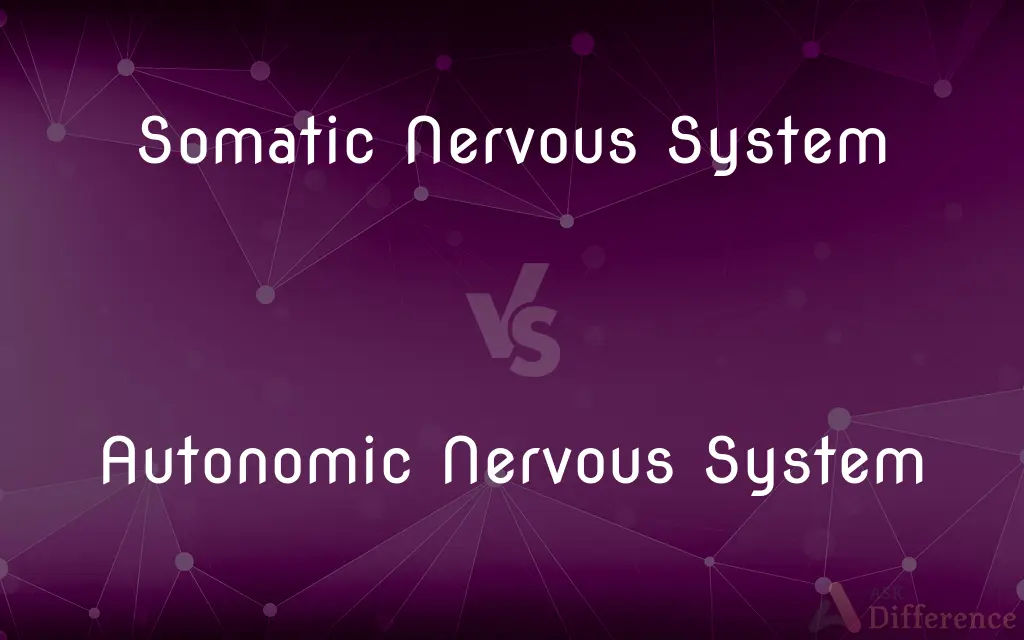Somatic Nervous System vs. Autonomic Nervous System — What's the Difference?
Edited by Tayyaba Rehman — By Fiza Rafique — Published on December 9, 2023
Somatic Nervous System controls voluntary muscle movements; Autonomic Nervous System regulates involuntary bodily functions like heartbeat.

Difference Between Somatic Nervous System and Autonomic Nervous System
Table of Contents
ADVERTISEMENT
Key Differences
The Somatic Nervous System and the Autonomic Nervous System are both critical components of the peripheral nervous system. Each plays a distinct role in how our bodies function and respond to external and internal stimuli.
The Somatic Nervous System is directly responsible for voluntary muscle actions. When you decide to move your arm or walk, the Somatic Nervous System is at work. Conversely, the Autonomic Nervous System operates without conscious control, managing vital functions like breathing, digestion, and heart rate.
An essential difference between the Somatic Nervous System and the Autonomic Nervous System lies in their motor pathways. The former usually involves one motor neuron, while the latter involves a sequence of two motor neurons.
The Somatic Nervous System communicates largely with skeletal muscles, facilitating conscious movement. In contrast, the Autonomic Nervous System interacts with internal organs and glands, ensuring the body's internal environment remains stable and balanced.
While both the Somatic Nervous System and the Autonomic Nervous System are integral for human survival, they serve distinct functions. The Somatic facilitates intentional interactions with the environment, whereas the Autonomic maintains the body's internal status quo.
ADVERTISEMENT
Comparison Chart
Control Type
Voluntary
Involuntary
Major Functions
Muscle movement
Regulation of internal organs and glands
Motor Pathway
Typically involves one motor neuron
Involves a sequence of two motor neurons
Interacts With
Skeletal muscles
Internal organs and glands
Subdivisions
N/A
Sympathetic and Parasympathetic systems
Compare with Definitions
Somatic Nervous System
Facilitates conscious interactions with the environment.
Catching a ball is a conscious action managed by the Somatic Nervous System.
Autonomic Nervous System
Functions without conscious thought.
Sweating in a hot environment is automatically controlled by the Autonomic Nervous System.
Somatic Nervous System
Interacts primarily with skeletal muscles.
When lifting weights, the Somatic Nervous System engages specific muscles.
Autonomic Nervous System
Interacts with internal organs and glands.
The secretion of saliva is managed by the Autonomic Nervous System.
Somatic Nervous System
Uses sensory receptors for touch, pain, and temperature.
Feeling the warmth of a cup is detected by the Somatic Nervous System.
Autonomic Nervous System
Regulates involuntary body functions.
Your heart rate increases during a fright due to the Autonomic Nervous System.
Somatic Nervous System
Oversees voluntary muscle actions.
Moving your fingers to type involves the Somatic Nervous System.
Autonomic Nervous System
Divided into sympathetic and parasympathetic systems.
The Autonomic Nervous System controls pupil dilation through its subdivisions.
Somatic Nervous System
Relies on one motor neuron pathway.
Jumping in the air is a direct response executed by the Somatic Nervous System.
Autonomic Nervous System
Ensures internal homeostasis.
Adjusting digestive processes is a task for the Autonomic Nervous System.
Common Curiosities
Does the Somatic Nervous System function automatically?
No, the Somatic Nervous System oversees voluntary actions.
Are there subdivisions within the Autonomic Nervous System?
Yes, the Autonomic Nervous System has two subdivisions: the sympathetic and parasympathetic systems.
How does the motor pathway of the Somatic Nervous System differ from the Autonomic Nervous System?
The Somatic Nervous System typically involves one motor neuron, while the Autonomic Nervous System uses a sequence of two motor neurons.
Which system interacts primarily with skeletal muscles?
The Somatic Nervous System interacts primarily with skeletal muscles.
Which system has sensory receptors for touch and temperature?
The Somatic Nervous System has sensory receptors for touch, pain, and temperature.
Which system is responsible for involuntary actions like heart rate and digestion?
The Autonomic Nervous System regulates involuntary actions like heart rate and digestion.
Which system controls voluntary muscle movements, the Somatic Nervous System or the Autonomic Nervous System?
The Somatic Nervous System controls voluntary muscle movements.
Which system ensures the body's internal environment remains stable?
The Autonomic Nervous System ensures internal homeostasis.
Which nervous system is responsible for the relaxation response after a stressor?
The parasympathetic division of the Autonomic Nervous System is responsible for the relaxation response.
How do the two systems work together in daily life?
While the Somatic Nervous System controls conscious actions, the Autonomic Nervous System maintains internal balance, allowing coordinated responses to environmental changes.
What are the main functions of the Autonomic Nervous System?
The Autonomic Nervous System regulates involuntary body functions like heartbeat, digestion, and breathing.
Can we consciously control the Autonomic Nervous System?
Generally, no. The Autonomic Nervous System functions without conscious control, though certain practices like meditation can influence it.
Are the Somatic Nervous System and Autonomic Nervous System parts of the central nervous system?
No, both are components of the peripheral nervous system.
Is the Somatic Nervous System involved in the fight-or-flight response?
No, the fight-or-flight response is managed by the sympathetic division of the Autonomic Nervous System.
Do both systems play a role in overall human survival?
Yes, both the Somatic Nervous System and the Autonomic Nervous System are integral for human survival.
Share Your Discovery

Previous Comparison
Gluconic Acid vs. Glucuronic Acid
Next Comparison
Alpha Alumina vs. Gamma AluminaAuthor Spotlight
Written by
Fiza RafiqueFiza Rafique is a skilled content writer at AskDifference.com, where she meticulously refines and enhances written pieces. Drawing from her vast editorial expertise, Fiza ensures clarity, accuracy, and precision in every article. Passionate about language, she continually seeks to elevate the quality of content for readers worldwide.
Edited by
Tayyaba RehmanTayyaba Rehman is a distinguished writer, currently serving as a primary contributor to askdifference.com. As a researcher in semantics and etymology, Tayyaba's passion for the complexity of languages and their distinctions has found a perfect home on the platform. Tayyaba delves into the intricacies of language, distinguishing between commonly confused words and phrases, thereby providing clarity for readers worldwide.
















































